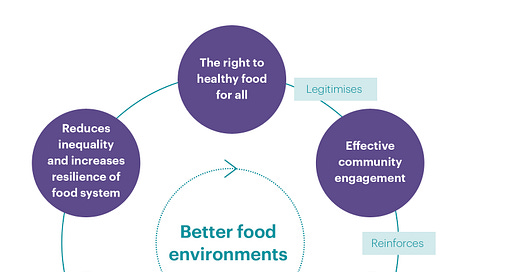Welcome to Just Two Things, which I try to publish daily, five days a week. Some links may also appear on my blog from time to time. Links to the main articles are in cross-heads as well as the story.
Suddenly a whole lot of my projects are being published in a rush. Last year I worked with Impact on Urban Health in London (Guy’s and St Thomas Charity, as was) on a project looking at the future of urban food environments. After a delay for their rebranding, this has been published this week.
The headline from the work—which surprised me, because I hadn’t expected to end up here—is that the food market is broken, and shows huge signs of market failure. By this, I mean that the external costs of an unhealthy food system are spilling out everywhere, into the health system, the planet, into individual life chances, and the food sector is largely able to walk away from these.
The details of the approach are in the report, but in summary:
- we used a drivers’ scan as a platform to build a set of domains that represented the future landscape;
- we used causal loops to interrogate these and develop hypotheses;
- our research partner, Shift, took these hypotheses into community research and tested them;
- we identified several “platforms for change” that could change the way the food market operated;
- and we combined these into a flywheel that represented a theory of sector change.
Along the way we engaged with stakeholders to test and deepen the domains, and to explore the platforms for change.
The report has quite a lot on all of this, but I’m just going to quickly describe the six domains and then share the flywheel.
Climate ready foods: As environmental pressures come to a head, will the food system adapt to be more resilient to shocks in an equitable way? Or will households with lower incomes face reduced access to fresh food, and be left behind in the transition to nutritious meat alternatives and sustainable fresh food?
Fragmenting food consumers. As long-term changes in consumer demand patterns put more pressure on the food sector to deliver convenience and immediacy, can this be delivered in a way that’s profitable and healthy?
Profitable purpose. As the external costs of businesses continue to increase and ‘millennial’ values become more influential among managers and leaders, how will social purpose and social innovation re-shape the food sector?
Changing views on inequality. As the social and political discourse around inequality in the UK evolves, what initiatives to provide universal basic services or income will emerge and how soon?
Placemaking under pressure. As the decline of the high street continues and local councils face budget constraints, will the future of local placemaking be shaped by private sector interests? Or will local communities increase their influence over how space is used?
Health in the chain. As awareness of the lifetime costs of unhealthy diets rises, will regulators and businesses work together to increase access to healthier options in lower income areas? Or will corporate lobbying protect food deserts from regulation?
The different social innovation platforms that emerged from this analysis and from the community research were, in headline only:
- Enshrine access to healthy food as a right;
- Enable local communities to demand better and play a part in change;
- Support and promote values-led actors in the food system;
- Raise the regulatory floor to set better parameters for the food environment.
These fed into a flywheel for positive change that we developed during the analysis period.
At the top of the flywheel is ‘The right to healthy food for all’—meaning, obviously, the right to healthy affordable, accessible food for all. As soon as you realise the public costs that the current food system generates, healthy and affordable food becomes a credible option. But we do need to do do some more thinking about how the business model works.
Shift has also done some great design work on the report outcomes—for example on the microsite here.
#2: Elites are the carbon problem
We worry about how to get emissions down fast enough to hit our climate targets. It seems that a simple solution might be staring us in the face.
An evidence review from the Cambridge Sustainability Commission—looking at emissions over the period 1990 to 2015, found that the richest 5% globally contributed 37% of the growth in absolute emissions levels:
The report shows that a combination of efforts to dramatically reduce the carbon footprints of the richest and to build affordable and low-carbon infrastructures around housing, transport and energy for poorer households offers the best way forward. It further goes on to say that, far from being competing approaches, changes to individual behaviour and systemic change are linked and can be positively self-reinforcing.
There are some clear policy implications from this, according to the researchers. They suggest
immediate steps to target the elites leading high emission lifestyles, and to develop new infrastructure to make low-carbon choices easier for poor households through measures targeting behaviour hotspots around travel, energy, housing and food such as:
frequent flyer levies
bans on selling and promoting SUVs and other high-polluting vehicles
reversing the recent announcement to cut green grants for homes and electric cars
building just transitions by supporting electric public transport and community energy schemes.
Two other points worth noting. The first is that the researchers use the phrase “polluter elite” in their news release—which is one of those phrases that could influence policy if it sticks. The other is they they suggest that there is scope to allow the world’s poorest to increase their emissions if those of the rich are brought under control.
j2t#101
If you are enjoying Just Two Things, please do send it on to a friend or colleague.



